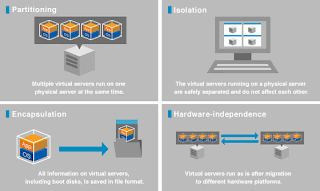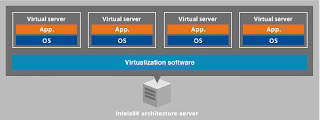
What is server virtualization?
Server virtualization is a technology for partitioning one physical server into multiple virtual servers. Each of these virtual servers can run its own operating system and applications, and perform as if it is an individual server. This makes it possible, for example, to complete development using various operating systems on one physical server or to consolidate servers used by multiple business divisions.
Among the various virtualization methods available, NEC primarily focuses on virtualization software solutions. Because the virtualization software, or hypervisor, used by NEC runs directly on bare hardware (physical servers), our virtualized environments have little overhead. NEC’s proven, reliable solutions are built upon years of experience with virtualization.
Among the various virtualization methods available, NEC primarily focuses on virtualization software solutions. Because the virtualization software, or hypervisor, used by NEC runs directly on bare hardware (physical servers), our virtualized environments have little overhead. NEC’s proven, reliable solutions are built upon years of experience with virtualization.
Server virtualization features
Primary advantages of server virtualizationReduce number of serversPartitioning and isolation, the characteristics of server virtualization, enable simple and safe server consolidation.
Through consolidating, the number of physical servers can be greatly reduced. This alone brings benefits such as reduced floor space, power consumption and air conditioning costs. However, it is essential to note that even though the number of physical servers is greatly reduced, the number of virtual servers to be managed does not change. Therefore, when virtualizing servers, installation of operation management tools for efficient server management is recommended.
Primary advantages of server virtualizationReduce number of serversPartitioning and isolation, the characteristics of server virtualization, enable simple and safe server consolidation.
Through consolidating, the number of physical servers can be greatly reduced. This alone brings benefits such as reduced floor space, power consumption and air conditioning costs. However, it is essential to note that even though the number of physical servers is greatly reduced, the number of virtual servers to be managed does not change. Therefore, when virtualizing servers, installation of operation management tools for efficient server management is recommended.
Reduce TCO
Server consolidation with virtualization reduces costs of hardware, maintenance, power, and air conditioning. In addition, it lowers the Total Cost of Ownership (TCO) by increasing the efficiency of server resources and operational changes, as well as virtualization-specific features. As a result of today’s improved server CPU performance, a few servers have high resource-usage rates but most are often underutilized. Virtualization can eliminate such ineffective use of CPU resources, plus optimize resources throughout the server environment. Furthermore, because servers managed by each business division's staff can be centrally managed by a single administrator, operation management costs can be greatly reduced.

Improve availability and business continuity
One beneficial feature of virtualized servers not available in physical server environments is live migration. With live migration, virtual servers can be migrated to another physical server for tasks such as performing maintenance on the physical servers without shutting them down. Thus there is no impact on the end user. Another great advantage of virtualization technology is that its encapsulation and hardware-independence features enhance availability and business continuity.
Increase efficiency for development and test environments
At system development sites, servers are often used inefficiently. When different physical servers are used by each business division's development team, the number of servers can easily increase. Conversely, when physical servers are shared by teams, reconfiguring development and test environments can be time and labor consuming.
Such issues can be resolved by using server virtualization to simultaneously run various operating system environments on one physical server, thereby enabling concurrent development and test of multiple environments. In addition, because development and test environments can be encapsulated and saved, reconfiguration is extremely simple.


